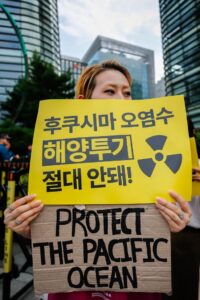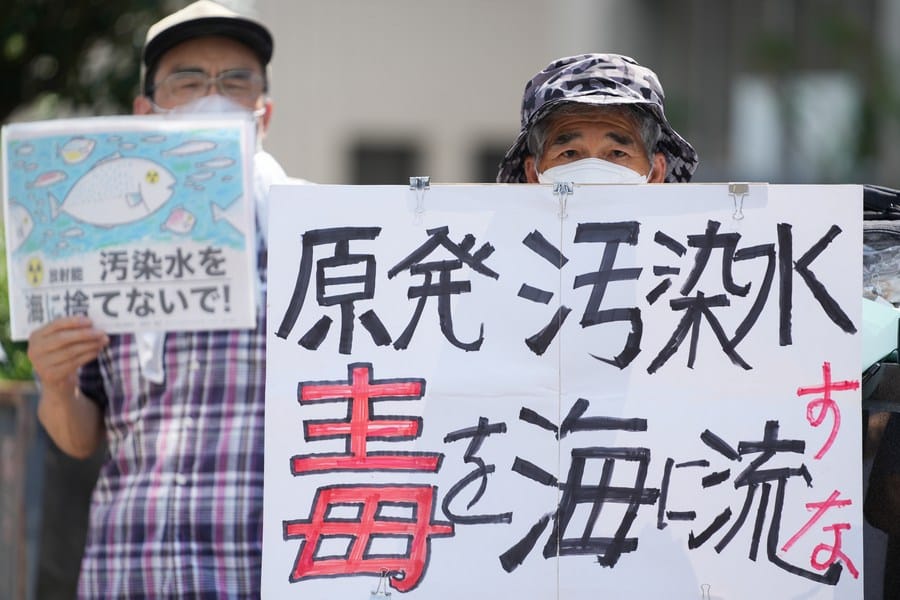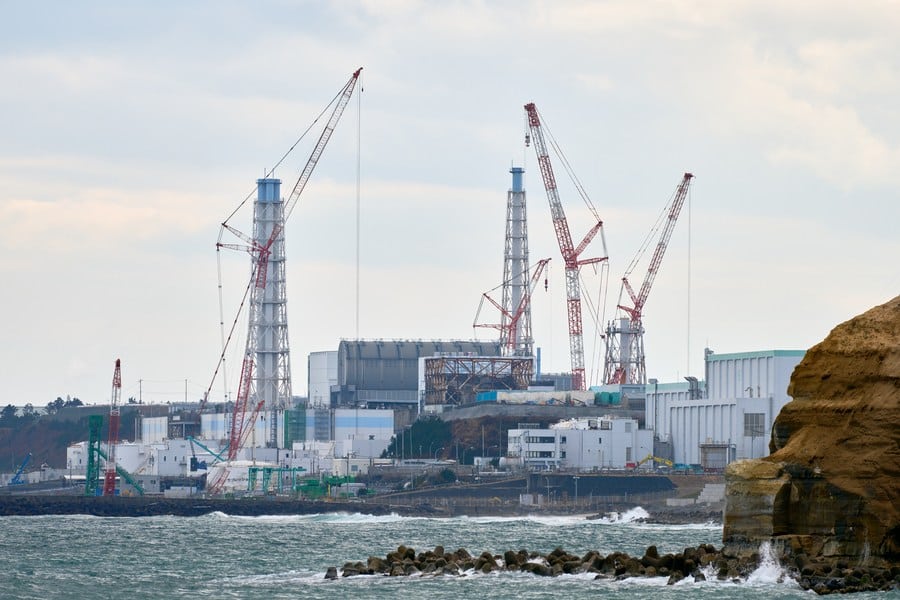Comparing Fukushima’s ‘treated water’ with a typical nuclear plant’s discharge is misleading, as the ‘treated water’ had direct contact with the melted reactor cores
By Huaxia
Despite public concerns and raging opposition from both home and abroad, Japan started releasing nuclear-contaminated wastewater from the crippled Fukushima Daiichi nuclear power plant into the Pacific ocean two weeks ago.
The ocean discharge, which could last several decades, has been planned for a long time. The incredibly selfish act blatantly violates international law and would impact the entire world.
LONG-PLOTTED MOVE
Three reactors melted and were destroyed when a tsunami struck Japan’s Fukushima Daiichi nuclear power plant in March 2011. The highly contaminated water produced while cooling the damaged reactors, mixed with rain and groundwater, has since accumulated in the reactor buildings.
In April 2011, the Tokyo Electric Power Company (TEPCO), the operator of the Fukushima plant, deliberately discharged nuclear-contaminated water into the sea, sparking widespread concern.
In March 2013, the Advanced Liquid Processing System (ALPS), a key facility for treating nuclear-contaminated water, was put into trial operation. Since then, TEPCO has referred to contaminated water treated in this multi-nuclide removal equipment as “treated water”.
The ALPS has frequently experienced malfunctions. It has failed to remove isotopes adequately, with the adsorbents used to remove radioactive isotopes being replaced less often than they were supposed to be.
As a result, 70 per cent of the water in the storage tanks still contains non-tritium radionuclides at a concentration that exceeds the regulatory standards applicable for discharge into the environment.
Where does the “treated water” go eventually?
As early as December 2013, Japan’s Ministry of Economy, Trade and Industry (METI) set up a subcommittee to conduct technical discussions on how to dispose of the ALPS “treated water”.
In June 2016, the working group released a report stating that among the five disposal options, namely discharge into the sea, underground burial, geosphere injection, vapour release and hydrogen release, diluting the “treated water” and discharging it into the sea is found to be the cheapest method.
The report set the tone for the subsequent ocean discharge plan. However, after its release, the report was vehemently opposed by Japanese agriculture, forestry and fishery groups. Even Masayoshi Yoshino, then minister for reconstruction, expressed his opposition to discharging treated nuclear-contaminated water into the sea.
Many experts have proposed various options for proper disposal. However, METI and TEPCO have deemed the ocean discharge plan an “established policy”.
In April 2021, despite persisting opposition from home and abroad, the Japanese government announced the controversial plan to discharge nuclear-contaminated wastewater into the sea in 2023. Since then, preparations for the ocean discharge were in full swing.
SELF-DIRECTED “AUTHORITATIVE VERIFICATION”
On July 4, director general of the International Atomic Energy Agency (IAEA) Rafael Grossi presented an assessment report on the disposal of Fukushima nuclear-contaminated water to the Japanese government during his visit to Japan.
The IAEA report concluded that the discharge plan “is in conformity with the agreed international standards”, and the Japanese side claimed that the plan’s safety had been “authoritatively verified”.
However, there are multiple doubts about the report. For starters, Japan made the ocean discharge decision before commissioning the IAEA to conduct a safety assessment. Clearly, it did not aim to find a scientific and reasonable solution to the problem but to use the agency to endorse its ocean discharge plan.
Secondly, before the IAEA assessment, Japan had already started making relevant arrangements for manipulating the “certification” process.
Tokyo Shimbun reported that the Japanese government had paid a large share of costs and other payments to the IAEA in the past, and various departments of the Japanese government had sent personnel to the IAEA, which would inevitably impact the IAEA assessment of the dumping plan.
South Korea’s main opposition Democratic Party lawmakers said in a meeting with Grossi on July 9 that the UN nuclear watchdog’s verification of the plan was biased in favour of Japan from the beginning, losing its neutrality and objectivity. Regrettably, the IAEA came to a hasty conclusion without considering the plan’s impact on neighbouring countries.
Thirdly, the IAEA report stressed at the beginning that it does not necessarily reflect the views of IAEA member states and is not a recommendation or an endorsement of Japan’s ocean discharge plan. The IAEA and its member states are not responsible for any consequences arising from the report.
Liu Senlin, a researcher with the China Institute of Atomic Energy who participated in the IAEA’s assessment work, said the report was released hastily and lacked sufficient consultation with experts.
Liu said that the IAEA’s assessment was limited as it neither included other possible disposal options nor addressed the effectiveness and long-term reliability of the water purification system.

Without confirmation of the data’s accuracy, equipment reliability and supervision effectiveness, it is impossible to conclude that releasing more than 1.3 million tons of nuclear-contaminated water into the ocean for up to 30 years is safe, Li added.
LACK OF SINCERITY
Having acknowledged that the ALPS cannot remove the radioactive substance of tritium from the nuclear-polluted water, TEPCO continues to assert that the impact of the substance on fish and its subsequent effect on humans through the food chain is “negligible”.
An aquatic breeding facility is set up at the crippled power plant as a platform to support this claim. Within this facility housing common flatfish found along the Fukushima coastline, one tank contains ordinary seawater, while another tank holds the treated nuclear-contaminated water, known as the “treated water”.
However, as highlighted in a report by a third-party group of experts invited by the Pacific Islands Forum (PIF), TEPCO has failed to assess the “long-term impact” of radioactive tritium’s conversion to organically bound tritium on marine ecology.
From a scientific perspective, both experts and environmental organisations are deeply sceptical about the data provided by TEPCO concerning the treatment of nuclear-contaminated water and related matters.
“The quantity and quality of the data are inadequate, incomplete and inconsistent to support a decision to release tank waters,” said Ferenc Dalnoki-Veress, a nuclear physics expert and adjunct professor at US Middlebury Institute of International Studies.
Environmental protection organisations have listed various problems with TEPCO’s claims about the so-called “treated water”: Certain radioactive substances remain above acceptable levels even after the ALPS treatment.
“Does TEPCO have the qualifications for ocean discharge?” Naoya Sekiya from the University of Tokyo questioned, noting that issues related to management and safety have not been isolated to Fukushima alone, as other TEPCO-run nuclear power plants have also experienced problems, leading to doubts about their capability for proper disposal of the wastewater.
TEPCO and the Japanese government’s breach of trust is also evident in their flip-flopping stance. In 2015, the Japanese government and TEPCO agreed with fisheries cooperative associations of both Fukushima prefecture and the nation that they would not proceed with any wastewater disposal “without the understanding of relevant parties”.
Despite their persistent efforts over the years to persuade those in the fishing industry, the Japanese government and TEPCO have not succeeded. Yet, they ignored their own promises by pushing ahead with the ocean discharge, disregarding strong public opposition.
“Nothing will change in our opposition to the release of water into the ocean without the understanding of fishermen and the public,” said Masanobu Sakamoto, head of the National Federation of Fisheries Cooperative Associations, in a statement last week.
The decades-long discharge’s potential harm to marine environments and the fisheries industry is self-evident. However, the Japanese government and TEPCO have spared no effort in a propaganda campaign, claiming the still contaminated water is “safe” instead of focusing on reducing the contaminated water’s impact on human beings and the environment.
Advertisements have been placed on television, in newspapers and online to promote the “safety” of nuclear-contaminated water.
In the Japanese side’s instructions on the discharge of nuclear-contaminated water into the sea, especially in foreign language materials, the term “treated water” is generally used instead of “nuclear-contaminated water”, intended to downplay its pollution characteristics and potential hazards.
In April, Japan sought to use its Group of Seven (G7) presidency to drum up endorsement from the wealthy bloc. However, it was slammed after G7 environment and energy ministers met in the Japanese city of Sapporo.
Despite opposition, Japan included the wording – “transparent efforts based on scientific evidence” and “support for independent IAEA review” – in the final G7 statement.
According to IAEA’s safety regulations regarding releasing radioactive materials into the environment, authorisation for such releases should involve providing information and consulting with interested parties, including “other states, especially neighboring states.”
However, facing concerns of neighbouring countries, Japan, instead of engaging in sincere communication, wantonly downplayed the release of the contaminated water and labelled other countries’ reasonable concerns about the marine environment and food safety as “playing politics”.
In July, the Chinese Embassy in Japan pointed out that Japanese statements regarding “dialogue and consultation with China” lacked sincerity, as it persisted in advancing the discharge plan according to its set schedule, disregarding China’s position.
The discharge of Fukushima nuclear-contaminated wastewater is not merely a domestic matter for Japan but a global concern impacting oceanic environments and human health. By ignoring international objections, reneging on international obligations, and forcefully proceeding with the discharge, the Japanese government poses threats to the environment and the legitimate rights of neighbouring countries.
History cannot be undone, and its repercussions are enduring. Japan’s selfish actions and shameful attempts to shift blame will undoubtedly stain its reputation.
(Xinhua)








Click here to change your cookie preferences